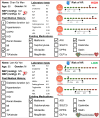PowerAI-Diabetes: Review of glycemic and lipid variability to predict cardiovascular events in Chinese diabetic population
- PMID: 40603602
- PMCID: PMC12118715
- DOI: 10.1038/s44324-024-00012-7
PowerAI-Diabetes: Review of glycemic and lipid variability to predict cardiovascular events in Chinese diabetic population
Abstract
The aim of this study is to review the predictive value of visit-to-visit variability in glycaemic or lipid tests for forecasting major adverse cardiovascular events (MACE) in diabetes mellitus. Data from existing studies suggests that such variability is an independent predictor of adverse outcomes in this patient cohort. This understanding is then applied to the development of PowerAI-Diabetes, a Chinese-specific artificial intelligence-enhanced predictive model for predicting the risks of major adverse cardiovascular events and diabetic complications. The model integrates an amalgam of variables including demographics, laboratory and medication information to assess the risk of MACE. Future efforts should focus on the incorporation of treatment effects and non-traditional cardiovascular risk factors, such as social determinants of health variables, to improve the performance of predictive models.
© 2024. The Author(s).
Conflict of interest statement
Competing interests: The authors declare no competing interests.
Figures





Similar articles
-
The comparative and added prognostic value of biomarkers to the Revised Cardiac Risk Index for preoperative prediction of major adverse cardiac events and all-cause mortality in patients who undergo noncardiac surgery.Cochrane Database Syst Rev. 2021 Dec 21;12(12):CD013139. doi: 10.1002/14651858.CD013139.pub2. Cochrane Database Syst Rev. 2021. PMID: 34931303 Free PMC article.
-
Systematic review on urine albumin testing for early detection of diabetic complications.Health Technol Assess. 2005 Aug;9(30):iii-vi, xiii-163. doi: 10.3310/hta9300. Health Technol Assess. 2005. PMID: 16095545
-
Individual-level interventions to reduce personal exposure to outdoor air pollution and their effects on people with long-term respiratory conditions.Cochrane Database Syst Rev. 2021 Aug 9;8(8):CD013441. doi: 10.1002/14651858.CD013441.pub2. Cochrane Database Syst Rev. 2021. PMID: 34368949 Free PMC article.
-
Treatment of periodontitis for glycaemic control in people with diabetes mellitus.Cochrane Database Syst Rev. 2022 Apr 14;4(4):CD004714. doi: 10.1002/14651858.CD004714.pub4. Cochrane Database Syst Rev. 2022. PMID: 35420698 Free PMC article.
-
Signs and symptoms to determine if a patient presenting in primary care or hospital outpatient settings has COVID-19.Cochrane Database Syst Rev. 2022 May 20;5(5):CD013665. doi: 10.1002/14651858.CD013665.pub3. Cochrane Database Syst Rev. 2022. PMID: 35593186 Free PMC article.
References
-
- Kannel, W. B. & McGee, D. L. Diabetes and glucose tolerance as risk factors for cardiovascular disease: the Framingham study. Diabetes Care2, 120–126 (1979). - PubMed
-
- Harris, S. B. et al. Person-centered, outcomes-driven treatment: a new paradigm for type 2 diabetes in primary care. ADA Clin.Compend. 202010.2337/db2020-02 (2020). - PubMed
-
- Bailey, C. J. et al. Individualized glycaemic targets and pharmacotherapy in type 2 diabetes. Diabetes Vasc. Dis. Res.10, 397–409 (2013). - PubMed
Publication types
LinkOut - more resources
Full Text Sources
